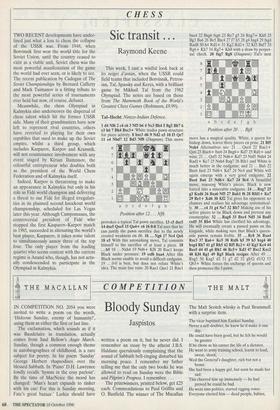CHESS
Sic transit ...
Raymond Keene
TWO RECENT developments have under- lined just what a loss to chess the collapse of the USSR was. From 1948, when Botvinnik first won the world title for the Soviet Union, until the country ceased to exist as a viable unit, Soviet chess was the most powerful manifestation of the game the world had ever seen, or is likely to see. The recent publication by Cadogan of The Soviet Championships by Bernard Cafferty and Mark Taimanov is a fitting tribute to the most powerful series of tournaments ever held but now, of course, defunct.
Meanwhile, the chess Olympiad in Kalmykia also underscores the dispersal of chess talent which hit the former USSR side. Many of their grandmasters have now left to represent rival countries, others have reverted to playing for their own republics that used to make up the Soviet empire, whilst a third group, which includes Kasparov, Karpov and ICramnik, will not countenance involvement with any event staged by Kirsan Ilumzinov, the colourful entrepreneur who doubles both as the president of the World Chess Federation and of Kalmykia itself. Indeed, Karpov is threatening to make an appearance in Kalmykia but only in his role as Fide world champion and delivering a threat to sue Fide for illeged irregulari- ties in its planned second knockout world championship, scheduled for Las Vegas later this year. Although Campomanes, the controversial president of Fide who stopped the first Kasparov—Karpov match in 1985, succeeded in alienating the world's best player, Kasparov, it takes some talent to simultaneously annoy three of the top four. The only player from the leading quartet who seems content with the current regime is Anand who, though, has not actu- ally condescended to participate in the Olympiad in Kalmykia. This week, I cast a wistful look back at les neiges d'antan, when the USSR could field teams that included Botvinnik, Petros- ian, Tal, Spassky and Keres, with a brilliant game by Mikhail Tal from the 1962 Olympiad. The notes are based on those from The Mammoth Book of the World's Greatest Chess Games (Robinson, £9.99).
Tal-Hecht: Nimzo -Indian Defence.
1 d4 Nf6 2 c4 e6 3 Nf3 b6 4 Nc3 Blb4 5 Bg5 Bb7 6 e3 h6 7 Bh4 Bxc3+ White trades pawn structure for piece activity. 8 bxc3 d6 9 Nd2 e5 10 13 Qe7 11 e4 Nbd7 12 Bd3 Nf8 (Diagram) This move provokes a typical Tal pawn sacrifice. 13 c5 dxc5 14 dxe5 Qxe5 15 Qa4+ c6 16 0-0 Tal sees that he can justify the pawn sacrifice due to the newly created weakness on d6. 16 ...Ng6 17 Nc4 Qe6 18 e5 With this astonishing move, Tal commits himself to the sacrifice of at least a piece. 18 b5 18 ...Nach4 19 Nd6+ Kf8 20 Rael keeps Black under pressure. 19 exf6 bxa4 After this Black seems unable to avoid a difficult endgame.
19 ... 0-0 is best, but does not refute White's idea. The main line runs: 20 Rael Qxel 21 Rxel
bxa4 22 Bxg6 fxg6 23 Re7 g5 24 Rxg7+ Kh8 25 Bg,3 Ba6 26 Be5 Bxc4 27 17 h5 28 g4 hxg4 29 fxg4 Rad8 30 h4 Rdl + 31 Kg2 Rd2+ 32 Kf3 Bxf7 33 Rg6+ Kh7 34 Rg7+ Kh8 with a draw by perpet- ual check. 20 fxg7 Rg8 (Diagram) Tars next Position after 20 . . . Rg8 move has a magical quality. White, a queen for bishop down, leaves three pieces en prise. 21 Bf5 Nxh4 Alternatives are: 21 ... Qxc4 22 Rael+ Qe6 23 Rxe6+ fxe6 24 Bxg6+ Kd7 25 Rdl + and wins; 21 ... Qxf5 22 Nd6+ Kd7 23 Nxf5 Nxh4 24 Radl + Kc7 25 Nxh4 Rxg7 26 Rfel and White is much better in the endgame; and 21 ...Ba6 22 Bxe6 fxe6 23 Nd6+ Kd7 24 Ne4 and White will again emerge with a very good endgame. 22 Bxe6 Ba6 23 Nd6+ Ke7 24 Bc4 A beautiful move, rescuing White's pieces. Black is now forced into a miserable endgame. 24 ...Rxg7 25 g3 KinI6 26 Bxa6 Nf5 27 Ftabl f6 28 Rfdl+ Ke7 29 Rel+ Kd6 30 Kf2 Tal gives his opponent no chances and realises his advantage systematical- ly. 30 ... c4 31 g4 Ne7 32 Rb7 Making use of his active pieces to tie Black down and prevent any counterplay. 32 ... Rag8 33 Bxc4 Nd5 34 Bxd5 cxd5 35 Rb4 White has clarified his advantage. He will eventually create a passed pawn on the kingside, while making sure that Black's queen- side pawns remain feeble. 35 ...Rc8 36 Rica4 Rxc3 37 Ra6+ Kc5 38 Rxf6 h5 39 h3 hxg4 40 hxg4 Rh7 41 g5 Rh5 42 Rf5 Rc2+ 43 Kg3 Kc4 44 Ree5 d4 45 g6 Rh! 46 Rc5+ Kd3 47 Rxc2 Kxc2 48 Kf4 Rgl 49 Rg5 Black resigns After 49 ... Rxg5 50 Kxg5 d3 51 g7 d2 52 g8/0 dl/Q 53 Qb3+ White forces the exchange of queens and then promotes the f-pawn.










































































 Previous page
Previous page